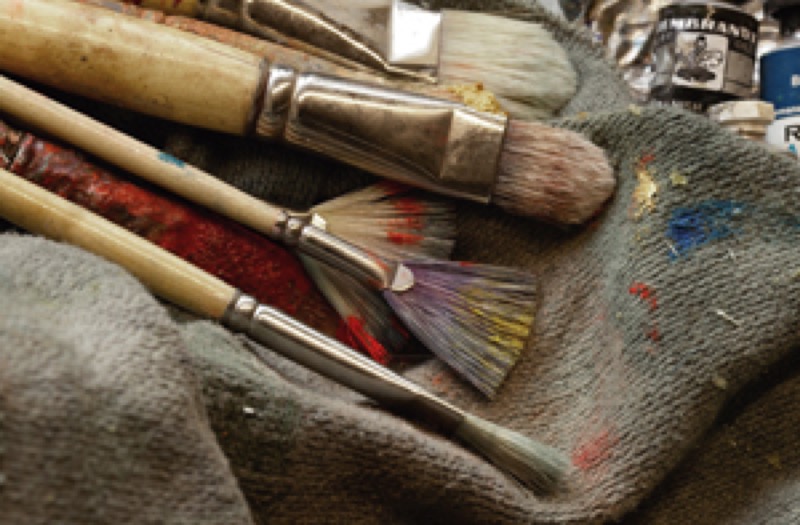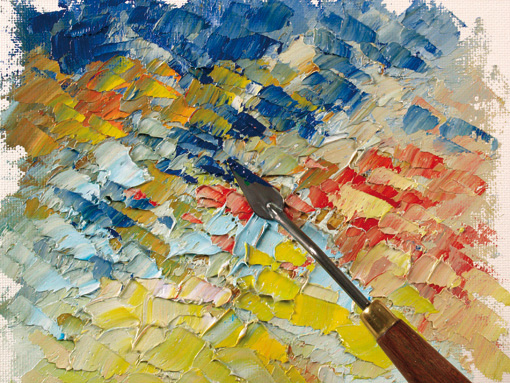Sizes, bristle types and shapes… Palette or painting knife… How do you decide?
Selecting knives and paintbrushes for painting with oils
Rate this tutorial
What you need to know: a matter of size
Paintbrush sizes can vary from one manufacturer to the next. With classifications ranging from thinnest to thickest and N°0 to N°24, brushes are classified differently depending on width. Every manufacturer has its own specifications, so thicknesses and lengths with the same number tend to vary.

1. Each bristles has its own stroke
Get 6 to 9 different paintbrushes to get started: with short and long, stiff and soft, thick and thin, flat and round bristles. Make sure to plan your paintbrush set on the basis of the use you will be putting it to.
- The filbert brush: flat, with a pointed tip. It produces a characteristic stroke, perfect for precision techniques and working on details.
- The round paintbrush (or filbert brush): with long bristles. For handling various thicknesses of curves and convoluted lines.
- The round paintbrush: fine point. For doing stippling or drawing long, continuous lines.
- The brush: a brush, with its square bristles, is indispensable in oil painting. Use it to apply little dabs, pressing the bristles down into the medium.
Memo: Short- or long-haired?
These are the two kinds of paintbrushes.
- Short-haired: flat, with short bristles and flat ends. For a precise, straight stroke!
- Long-haired: round or flat with long bristles. Perfect for diluted paints.
2. Natural or synthetic bristles?
Because oil paints are particularly thick and creamy, you need to work with paintbrushes with sturdy, fairly stiff bristles. You will want to transpose the color on the palette to the medium, to spread it and shape it: select high quality paintbrushes!
Natural bristles
- Boar bristles: they are stiff and thick, with all the right qualities for oil painting techniques, particularly impastos.
- Ox hair: these soft, supple paintbrushes are designed for applying diluted colors.
3. Synthetic fibers
They perform with almost as much precision as natural bristles! Their bristles tend to wear out faster; however, oil painting does not require keeping the tip in perfect condition (unlike watercolors). Very good price / quality ratio!
Memo: Quick anatomy of the paintbrush
A paintbrush has the following features:
A. Bristles: whether they have synthetic fibers or natural bristles, they need to hold their shape even when wet.
B. Bristles: they absorb paint and gradually release it.
C. Heel: this is the area where the fibers are inserted in the ferrule.
D. Ferrule: an actual metal collar that holds the handle and bristles together.
E. Handle: protected by varnish, it generally carries the name of the manufacturer, range, size and selected fiber.
Image


4. Knives
The essential tools of oil painting!
- The palette knife
It is used for mixing several colors together on the palette, or a color plus a medium. A palette knife consists of a straight, relatively flexible blade with a rounded end, and a handle. It comes in several sizes (from 5 to 20 cm): get a little one and a big one!
- The painting knife
A painting knife is made of thin, springy steel, with a fine, flexible blade, prolonged by a shaft and a wooden handle. Its use varies depending on the blade:
- A beveled tip is used for scraping paint.
- A rounded tip is for spreading paint.
When starting off, one round and one pointed knife will be adequate. You can complete your set depending on your needs and experience!
Memo: Painting knife or palette knife?
The painting knife is mainly used to move paint from the palette to the surface of the medium and to apply paint directly to the medium.
Recommended product:
Figueras®
